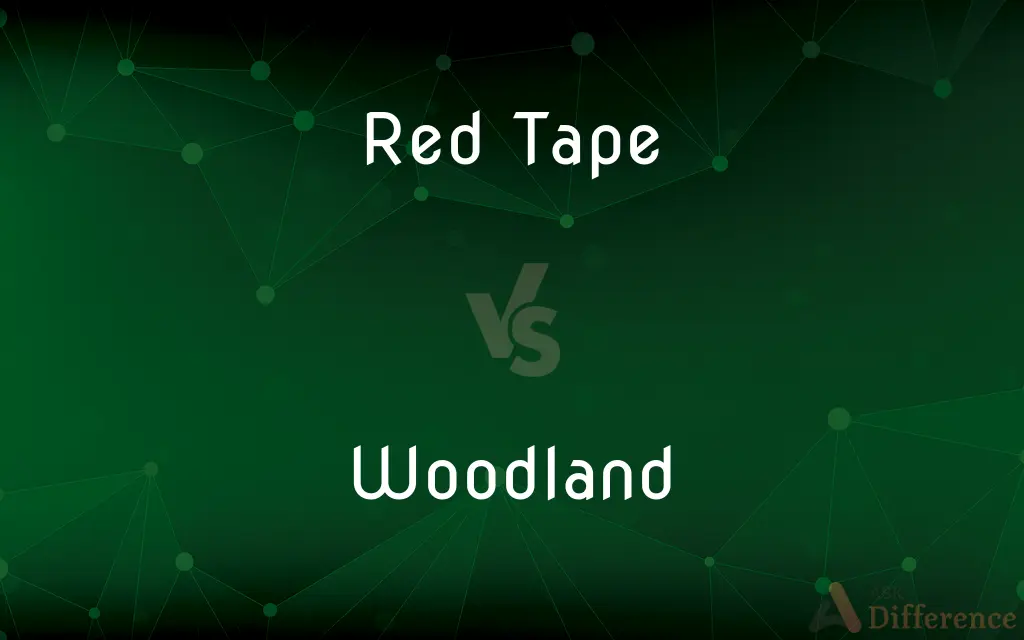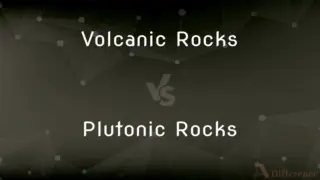Red Tape vs. Woodland — What's the Difference?
By Tayyaba Rehman — Published on January 28, 2024
Red Tape refers to excessive bureaucracy or adherence to rules and formalities, often causing delay. Woodland describes a dense area of trees, a natural environment distinct from bureaucratic connotations.

Difference Between Red Tape and Woodland
Table of Contents
ADVERTISEMENT
Key Differences
Red Tape symbolizes the complex procedures and excessive paperwork often encountered in organizations, leading to inefficiencies. In contrast, Woodland refers to an area covered with a dense growth of trees, symbolizing a natural, untouched environment.
The term Red Tape is frequently used in a negative context, highlighting the frustrating aspects of administrative procedures. Woodland, on the other hand, is associated with nature, tranquility, and the habitat of various wildlife, offering a positive and serene imagery.
Red Tape often implies a hindrance to progress due to strict adherence to rules, which can be seen in government or corporate settings. Conversely, Woodland evokes a sense of freedom and escape from the man-made world, representing a natural refuge.
In addressing Red Tape, there is often a call for simplification and streamlining of processes to improve efficiency. Woodland, in contrast, is typically discussed in the context of conservation, environmental importance, and the need for protection from development and deforestation.
While Red Tape is a human-created concept, subject to change and criticism, Woodland represents a more static, natural entity, shaped by ecological and geographical factors rather than human regulations.
ADVERTISEMENT
Comparison Chart
Definition
Bureaucratic procedures and formalities
Dense growth of trees in a natural area
Context of Use
Administrative, corporate settings
Environmental, nature-related discussions
Connotations
Negative, hindrance, inefficiency
Positive, tranquility, natural beauty
Associated Actions
Streamlining, simplifying processes
Conservation, protection, environmental care
Human Influence
Human-created, subject to change
Natural, less influenced by human activity
Compare with Definitions
Red Tape
Excessive bureaucracy in administrative processes.
The new policy was delayed due to Red Tape in the approval process.
Woodland
An area covered densely with trees.
The Woodland was lush and green, providing a habitat for wildlife.
Red Tape
Complex procedures causing delays.
The project's progress was stalled by the Red Tape involved.
Woodland
A forested area, often a place for recreation.
The city park includes a beautiful Woodland area for visitors to explore.
Red Tape
Adherence to strict rules and formalities.
Red Tape often prevents quick implementation of necessary changes.
Woodland
A natural environment characterized by forest.
They went hiking in the Woodland to enjoy the tranquility of nature.
Red Tape
A barrier to efficiency due to over-regulation.
Entrepreneurs frequently complain about Red Tape hindering business growth.
Woodland
A symbol of natural beauty and wilderness.
Artists often depict Woodland scenes to capture the essence of nature.
Red Tape
Overemphasis on procedure over practicality.
Red Tape can often overshadow the goal of serving the public efficiently.
Woodland
A habitat for various flora and fauna.
The Woodland ecosystem is vital for maintaining biodiversity.
Woodland
Of or relating to a Native American culture prevalent throughout much of eastern North America beginning around 1000 BC and lasting especially in northeastern regions until contact with Europeans, characterized by increasing reliance on settled agriculture, by the development of Neolithic crafts and tools, and in certain areas by the building of ceremonial mounds.
Woodland
Of, relating to, or constituting woodland.
Woodland
Living, growing, or present in woodland
Woodland flowers.
Woodland
Land covered with trees.
Woodland
Of a creature or object: growing, living, or existing in a woodland.
The woodland creatures ran from the fire.
Woodland
(obsolete) Having the character of a woodland.
Woodland
Land covered with woody vegetation.
Woodland
Land covered with wood or trees; forest; land on which trees are allowed to grow, either for fuel or timber.
Here hills and vales, the woodland and the plain,Here earth and water seem to strive again.
Woodlands and cultivated fields are harmoniously blended.
Woodland
Of or pertaining to woods or woodland; living in the forest; sylvan.
She had a rustic, woodland air.
Like summer breeze by woodland stream.
Woodland
Land that is covered with trees and shrubs
Common Curiosities
What does Red Tape typically refer to?
It refers to excessive bureaucracy and strict adherence to formalities.
Are Woodlands important for the environment?
Yes, they play a crucial role in biodiversity and ecological balance.
Can Red Tape be reduced?
Yes, through simplification and streamlining of administrative processes.
Can Red Tape affect business operations?
Yes, it can lead to delays and added costs for businesses.
Is Red Tape always negative?
Generally, it's seen negatively due to its association with inefficiency and delay.
Are Woodlands always large areas?
Not necessarily; Woodlands vary in size from small groves to extensive forests.
Can Woodlands be found in urban areas?
Yes, urban Woodlands exist and provide important green spaces in cities.
What does Woodland represent?
It represents a natural area densely populated with trees and wildlife.
Is Red Tape a modern concept?
It's a concept that has evolved with complex administrative systems over time.
How do people typically use the term Woodland?
It's used to describe natural forested areas, often in the context of nature appreciation or environmental issues.
Are Woodlands protected by law?
Many Woodlands are protected under environmental laws to preserve their ecological value.
Can human activities impact Woodlands?
Yes, activities like deforestation and development can significantly impact Woodland areas.
Does Red Tape serve any positive purpose?
It can, in ensuring thoroughness and compliance with regulations, though it's often seen as overly cumbersome.
Is Red Tape present in all organizations?
While it's more common in larger organizations and governments, any institution can have Red Tape.
Can individuals help reduce Red Tape?
Yes, by advocating for more efficient processes and supporting reforms in bureaucratic systems.
Share Your Discovery

Previous Comparison
Volcanic Rocks vs. Plutonic Rocks
Next Comparison
IIR Filters vs. FIR FiltersAuthor Spotlight
Written by
Tayyaba RehmanTayyaba Rehman is a distinguished writer, currently serving as a primary contributor to askdifference.com. As a researcher in semantics and etymology, Tayyaba's passion for the complexity of languages and their distinctions has found a perfect home on the platform. Tayyaba delves into the intricacies of language, distinguishing between commonly confused words and phrases, thereby providing clarity for readers worldwide.













































